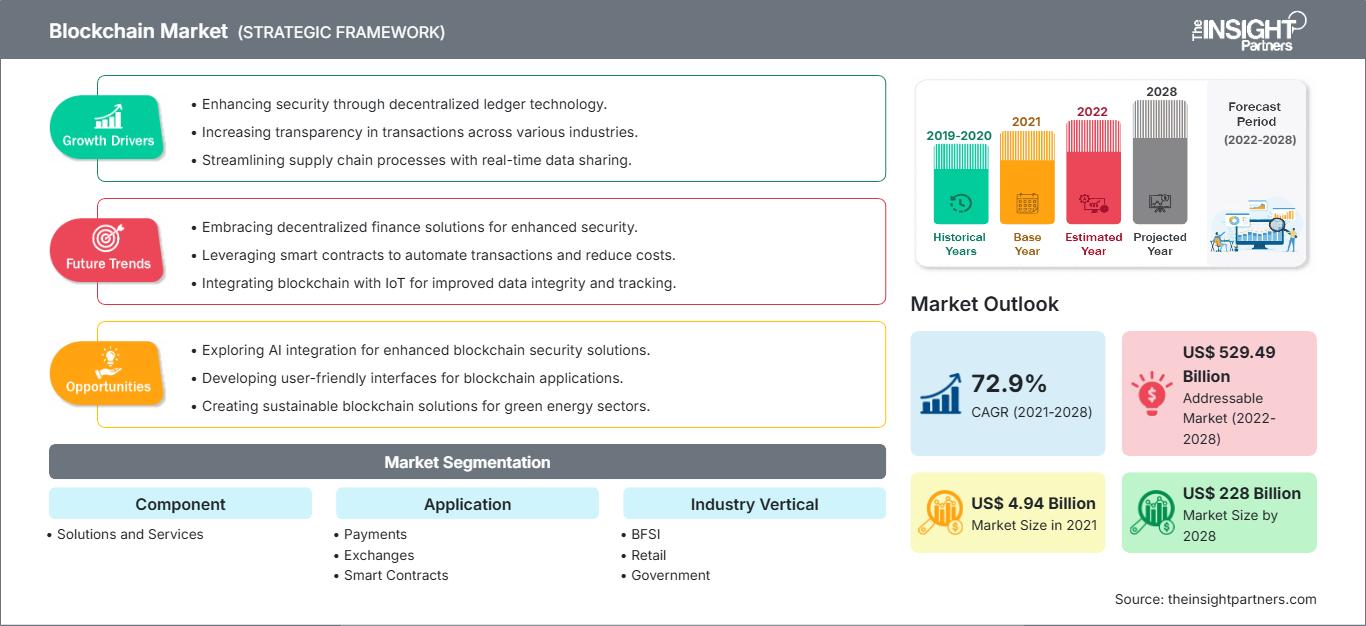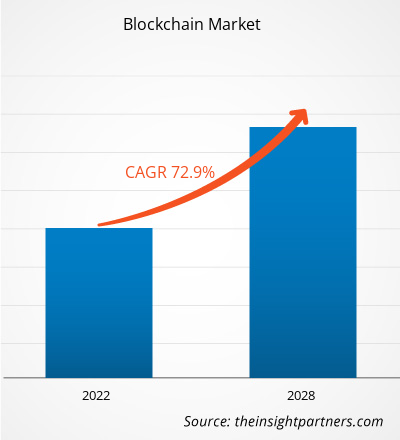页面已更新 :
Jun 2025
预计区块链市场规模将从 2021 年的 49.35 亿美元增长到 2028 年的 2279.966 亿美元;预计 2021 年至 2028 年的复合年增长率为 72.9%。区块链技术及其在银行、金融服务和保险 (BFSI) 领域的应用在过去几年中引起了广泛关注,主要是因为它能够改变现有行业的基础和商业模式。目前,除了加密货币应用外,区块链的其他主要实际应用仍然在银行和金融领域;然而,各种公司和机构现在正在迅速开发基于区块链的解决方案来解决复杂的业务问题。一般而言,区块链是更广泛的分布式账本技术 (DLT) 的一个子集,它结合了三个重要概念——密码学、智能合约和分布式账本设计。分布式账本技术 (DLT) 是一种快速兴起的方法,它能够在各种数据存储/账本之间记录和共享数据。DLT 有助于在不同网络参与者组成的分布式网络中记录、共享和同步交易和数据。

新冠疫情对区块链市场的影响尽管新冠疫情给全球组织带来了重大问题,但区块链市场在危机期间却稳步增长。最重要的是,在整个疫情期间,医护人员已开始使用聊天、电子邮件、电话和视频对话对患者进行远程治疗,从而防止了病毒传播。因此,用于安全在线交易和对话数据的渗透测试工具的使用有所增加。各公司纷纷采用区块链技术,在混乱的环境中提供最佳安全性,这也是推动区块链市场垂直发展的关键因素。新冠疫情影响了社会的方方面面,包括个人和企业。互联网生态系统在全球范围内变得越来越重要。由于新冠疫情的爆发,企业对在线业务的依赖急剧增加。金融服务、保险和保险业、医疗保健和生命科学、制造业、零售业、运输和物流业以及其他行业正在使用互联网为消费者提供关键服务。供应商对区块链的需求激增。在新冠疫情 (COVID-19) 疫情爆发后,各国政府和监管机构已强制公共和私营机构采用远程办公和保持社交距离的新技术。自此以后,数字化业务实践和在家庭服务器上使用电子邮件已成为众多企业新的业务连续性计划 (BCP)。

应用细分洞察全球区块链市场细分为支付、交易所、智能合约、文档、数字身份、治理、风险与合规等。支付领域引领了区块链市场。其他领域包括数字投票、共享出行、广告等。区块链降低了成本,提高了安全性,增加了透明度,并缩短了交易时间,同时减少了对可信第三方的需求。区块链可以处理各种规则和配置。智能合约等应用程序可以极大地提高流程效率、可靠性、透明度并降低风险。区块链的潜在用途多种多样,而且这项技术正变得越来越流行。
预计全球区块链市场在不久的将来将呈现极高的增长势头。推动市场增长的主要因素包括:BFSI 领域广泛采用区块链解决方案;更高的透明度、更高的运营效率和显著的成本节约等优势;以及创新型初创企业数量的增加。在预测期内,政府支持和举措的增加,以及区块链与人工智能在高级应用领域的结合等趋势,预计将为区块链市场的参与者提供激动人心的机遇。
自定义此报告以满足您的要求
您将免费获得任何报告的定制,包括本报告的部分内容,或国家级分析、Excel 数据包,以及为初创企业和大学提供超值优惠和折扣
区块链市场: 战略洞察

-
获取本报告的主要市场趋势。这个免费样本将包括数据分析,从市场趋势到估计和预测。
区块链市场洞察
全球领先行业——包括银行、金融服务和保险 (BFSI)、零售、物流和运输、医疗保健、汽车、媒体和娱乐以及公共部门组织——正越来越多地将区块链、人工智能 (AI)、物联网 (IoT)、大数据和预测分析等颠覆性技术融入其运营中。其中,区块链已成为一股变革力量,因其经证实能够提供更高的透明度、提高运营效率并降低交易和管理成本而获得广泛采用。越来越多的成功部署和试点项目展现出实际效益,为区块链的加速应用奠定了基础。在快速发展的数字经济中,企业面临着保持竞争力的日益增长的压力,而区块链提供的去中心化、安全且防篡改的基础设施正有力地支持这一需求。此外,企业也逐渐认识到区块链的战略价值,因为它能够实现更敏捷、数据驱动的运营,并增进利益相关者之间的信任。在金融服务领域,区块链已广泛应用于跨境支付、资本市场、贸易融资、投资和财富管理以及证券清算和结算等领域。它能够简化和自动化传统的手动、耗时的流程,从而减少对中介机构的依赖,显著缩短处理时间,并最大限度地降低错误和欺诈的风险。此外,处理敏感数据的机构(例如医疗保健和政府)利用区块链来确保数据完整性和信息共享的安全。通过提供不可变的审计跟踪和实时数据访问,区块链可以增强监管合规性,并增强任何市场生态系统中所有参与者的信心。降低运营成本仍然是全球企业的核心目标。区块链通过优化工作流程效率和消除冗余验证流程,为实现这一目标做出了贡献。随着企业持续推行数字化转型战略,区块链被视为创新的关键推动力。它通过更快的服务、更高的数据准确性和更强的问责制来改善客户体验,使其成为提升业务韧性和可扩展性的长期资产。组件细分洞察
基于组件,区块链市场可分为服务和解决方案。解决方案细分市场引领着区块链市场。由于区块链解决方案能够提高比特币金融交易管理的透明度,并不断提升数字化水平,其采用率不断提高,这推动着区块链市场向前发展。客户可以使用市场的区块链平台创建私有、公共和联盟区块链环境,并构建自己的区块链应用程序和解决方案。个人、产品、应用程序和服务可以通过这些平台跨区块链网络、云提供商和企业进行交互。区块链市场区域洞察
The Insight Partners 的分析师已详尽阐述了预测期内影响区块链市场的区域趋势和因素。本节还讨论了北美、欧洲、亚太地区、中东和非洲以及南美和中美洲的区块链市场细分和地理位置。
区块链市场报告范围
| 报告属性 | 细节 |
|---|---|
| 市场规模 2021 | US$ 4.94 Billion |
| 市场规模 2028 | US$ 228 Billion |
| 全球复合年增长率 (2021 - 2028) | 72.9% |
| 历史数据 | 2019-2020 |
| 预测期 | 2022-2028 |
| 涵盖的领域 |
By 组件
|
| 覆盖地区和国家 |
北美
|
| 市场领导者和主要公司简介 |
|
区块链市场参与者密度:了解其对商业动态的影响
区块链市场正在快速增长,这得益于终端用户需求的不断增长,而这些需求的驱动因素包括消费者偏好的演变、技术进步以及对产品优势的认知度的提升。随着需求的增长,企业正在扩展其产品线,不断创新以满足消费者需求,并抓住新兴趋势,从而进一步推动市场增长。

- 获取 区块链市场 主要参与者概述
行业垂直类型细分洞察
区块链是一种分布式账本,能够自动验证和记录大量数字交易,无论交易位于何处。随着初创公司利用区块链技术提高整个数字信息网络的透明度,它们正在提高各个领域对区块链技术的认识。根据行业垂直领域,全球区块链市场分为BFSI、零售、政府、运输和物流、医疗保健、汽车、媒体和娱乐等。其他领域包括制造业、房地产、电力和公用事业、电信和体育。区块链市场参与者专注于通过整合先进技术和功能来竞争,从而实现新产品的创新和开发。例如,2019年,家乐福和雀巢与IBM合作,将区块链技术应用于食品领域。此次合作将推动基于区块链的网络快速扩张,从而提高零售商、种植商、批发商、加工商、分销商和制造商的全球食品供应链的透明度。区块链市场 & ndash; 公司简介
IBM公司、微软公司、埃森哲、亚马逊、SAP Se、惠普企业发展有限公司 (HPE)、甲骨文公司、英特尔公司、Ripple、Bitfury集团- 历史分析(2 年)、基准年、预测(7 年)及复合年增长率
- PEST和SWOT分析
- 市场规模、价值/数量 - 全球、区域、国家
- 行业和竞争格局
- Excel 数据集
近期报告
客户评价
购买理由
- 明智的决策
- 了解市场动态
- 竞争分析
- 客户洞察
- 市场预测
- 风险规避
- 战略规划
- 投资论证
- 识别新兴市场
- 优化营销策略
- 提升运营效率
- 顺应监管趋势
我们的客户































87-673-9708

ISO 9001:2015





 获取免费样品 - 区块链市场
获取免费样品 - 区块链市场